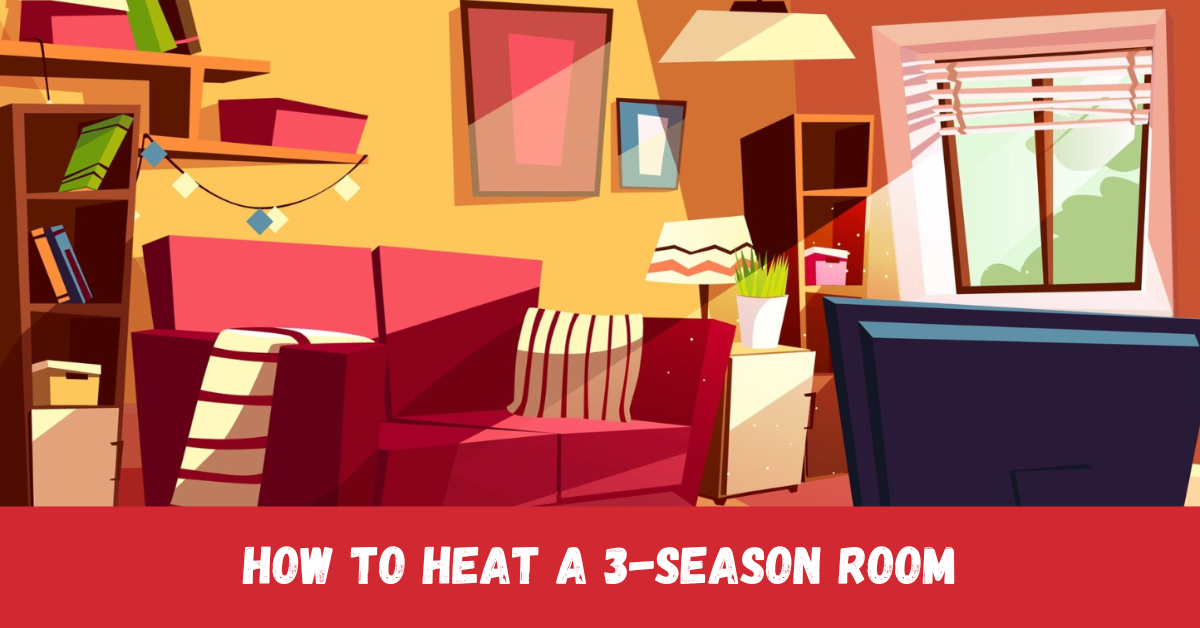A 3-season room is a fantastic home feature that allows you to enjoy nature with some shelter, usually spring, summer, and fall, but it can be challenging to keep warm when temperatures drop.
Whether it’s a sunroom, an uninsulated porch, or a more modern 4-season room, understanding how to effectively heat these spaces opens the door to enjoying them all year long.
This guide provides practical, energy-efficient solutions to keep your 3-season room cozy in winter, covering topics like the best way to heat a sunroom, options for heating an uninsulated porch, and tips on managing heating and cooling in a 4-season room.
How to Fix a Hot Room in House
Understanding the Basics of a 3-Season Room
A 3-season room is typically enclosed with windows but lacks full insulation, making it suitable for mild to warm weather but challenging to maintain comfortable temperatures during the winter months.
Commonly, these rooms include sunrooms, screened-in porches, or any area that lets natural light in but isn’t entirely protected from seasonal changes.
Because they’re not fully insulated, these rooms lose heat faster than other parts of the house, which makes it essential to select the right heating method.
How to Heat a 3-Season Room in Winter
When winter arrives, your 3-season room may require additional heating. Here are some popular heating methods that work well for 3-season rooms during colder months:
Electric Space Heaters
Electric space heaters are a straightforward and cost-effective way to heat a smaller 3-season room temporarily.
They come in various sizes and types, including fan-forced, ceramic, infrared, and oil-filled models. Here are a few tips to maximize efficiency with electric space heaters:
- Choose an Energy-Efficient Model: Look for energy-efficient options with automatic shut-off features for added safety.
- Position Carefully: Place the heater in a central area, away from windows and drafts, to distribute heat evenly.
- Insulate Windows and Doors: Seal windows and doors with weatherstripping or thermal curtains to reduce heat loss and ensure your heater’s efforts aren’t wasted.
Infrared Heaters
Infrared heaters work by directly heating objects and people in the room rather than the air itself. This method is especially beneficial in a 3-season room with poor insulation because infrared heat isn’t as affected by drafts or cold air from windows.
Consider an infrared heater with safety features and adjustable thermostat settings to tailor the warmth to your liking.
Portable Electric Fireplaces
For those who want a cozy atmosphere along with warmth, an electric fireplace can be an excellent choice. These units often come with adjustable flame settings, adding both aesthetic appeal and functional heat to the room.
While a portable electric fireplace isn’t as powerful as other heating methods, it can make the space more inviting and comfortable during the winter months.
Baseboard Heaters
Electric baseboard heaters can be permanently installed along the wall or as a portable unit. They’re silent, energy-efficient, and provide consistent heat for larger spaces. Baseboard heaters can be controlled individually, which means you can save on energy costs by using them only when needed.
Best Way to Heat a Sunroom
Sunrooms, like other 3-season rooms, are often exposed to temperature fluctuations due to their design. However, a few specific heating options work exceptionally well for sunrooms in winter:
Ductless Mini-Split System
A ductless mini-split system is among the best options for heating and cooling a sunroom. These systems are efficient, versatile, and require minimal installation work.
A mini-split consists of an outdoor unit connected to an indoor air handler mounted on a wall, which can heat or cool the space as needed.
This option allows for year-round climate control, making it an excellent choice if you plan to use your sunroom in both winter and summer.
Electric Floor Heating
Installing electric radiant floor heating can make a sunroom comfortable and inviting. This system heats the floor rather than the air, which keeps the room cozy without dealing with cold floors. While installation can be a bit more involved, it’s one of the most effective ways to heat a sunroom evenly.
Wood-burning or Pellet Stove
If your sunroom has the necessary ventilation and structural setup, a wood-burning or pellet stove can be a charming and effective heating solution.
These stoves offer significant heat output and add a warm ambiance to the space, although they do require regular maintenance and monitoring to ensure safety.
Radiant Wall Panels
Radiant wall panels are a less conventional but highly effective way to heat a sunroom. These panels can be mounted on the walls or ceiling and radiate heat that directly warms objects and people in the room. Since they don’t rely on air circulation, they’re ideal for spaces with drafts.
Heating an Uninsulated Porch
An uninsulated porch can be one of the trickiest spaces to heat during winter due to significant heat loss. However, some temporary heating solutions make it possible to keep your porch warm enough to enjoy for short periods:
Propane Heaters
Propane heaters are portable and produce substantial heat, making them ideal for uninsulated outdoor spaces like a porch.
Just ensure the area is ventilated to prevent carbon monoxide buildup. While these heaters can be cost-effective, they should only be used with caution, and only in well-ventilated spaces.
Patio Heaters
Patio heaters are typically used outdoors but can work for enclosed porches. Available in electric or propane versions, these heaters can provide targeted warmth. Although they won’t make the room as warm as other methods, they can be sufficient for short visits.
Insulated Curtains and Rugs
While not technically heating solutions, thermal curtains and thick rugs can make a difference on an uninsulated porch by trapping warm air and adding some insulation to the room.
Rugs help block out the chill from the floor, and curtains reduce drafts, allowing your heater to work more efficiently.
Heat Lamps
Heat lamps provide direct, focused warmth, making them an affordable option for small or localized areas on your porch. They’re ideal if you’re looking to warm a particular seating area rather than the entire porch.
Heating and Cooling a 4-Season Room
A 4-season room, unlike a 3-season room, is typically designed for year-round use and includes added insulation, stronger windows, and sometimes even HVAC connections.
Here’s how to heat and cool a 4-season room efficiently:
Ductless Mini-Split System
A mini-split system is another beneficial way as it offers an all-in-one heating and cooling solution, perfect for 4-season rooms.
Since it operates independently from your central HVAC system, it lets you control the temperature without adjusting the rest of the house. This is also one of the most energy-efficient solutions for 4-season rooms.
Extend Your HVAC System
If your 4-season room is directly adjacent to your house, extending your HVAC system into it may be possible. Here’s how you can do it.
This option requires professional installation and may include adding vents and ductwork. While this can be a more costly solution, it allows for seamless climate control and year-round comfort.
Ceiling Fans
In both winter and summer, ceiling fans can help regulate temperature as per requirements by circulating warm or cool air.
Many ceiling fans come with a switch that changes the rotation direction—clockwise in winter to push warm air downward and counterclockwise in summer to keep air cool.
This low-cost solution supports overall heating or cooling efforts, helping you maintain a comfortable environment.
Portable Air Conditioners and Space Heaters
For less permanent solutions, portable air conditioners or space heaters can be used to supplement heating or cooling as needed.
While they may not be as effective for large spaces, they provide flexible options that don’t require installation and can be put away when not in use.
Additional Tips for Efficient Heating and Cooling
Below, we have highlighted the proven tips that will you in heating or cooling a room with ease.
- Improve Insulation: Adding insulation is a long-term solution that can make heating and cooling more efficient, even in 3-season rooms. This can include insulating window frames, adding rugs, or even retrofitting walls if you’re considering a more permanent solution.
- Weatherproof the Windows and Doors: Simple additions like weatherstripping and thermal curtains can significantly reduce drafts and heat loss, ensuring that your heating or cooling efforts aren’t wasted.
- Use Smart Thermostats: If you’re using a mini-split or HVAC system, consider installing a smart thermostat. This lets you manage heating or cooling remotely and program your system to operate only when needed, saving energy and money.
- Consider Supplemental Insulation: Roll-up insulation panels can be installed temporarily for the colder months. They’re easy to install and remove, and they can make a noticeable difference in heat retention.
Heating a 3-season room doesn’t have to be an impossible task. With the right heating method, even uninsulated porches and sunrooms can become cozy winter spaces. From simple electric heaters and propane options to more sophisticated mini-split systems, there’s a solution that fits every need and budget. By choosing the right approach and adding insulating features, you can maximize your 3-season room’s use year-round and enjoy a comfortable, energy-efficient space no matter the season.

